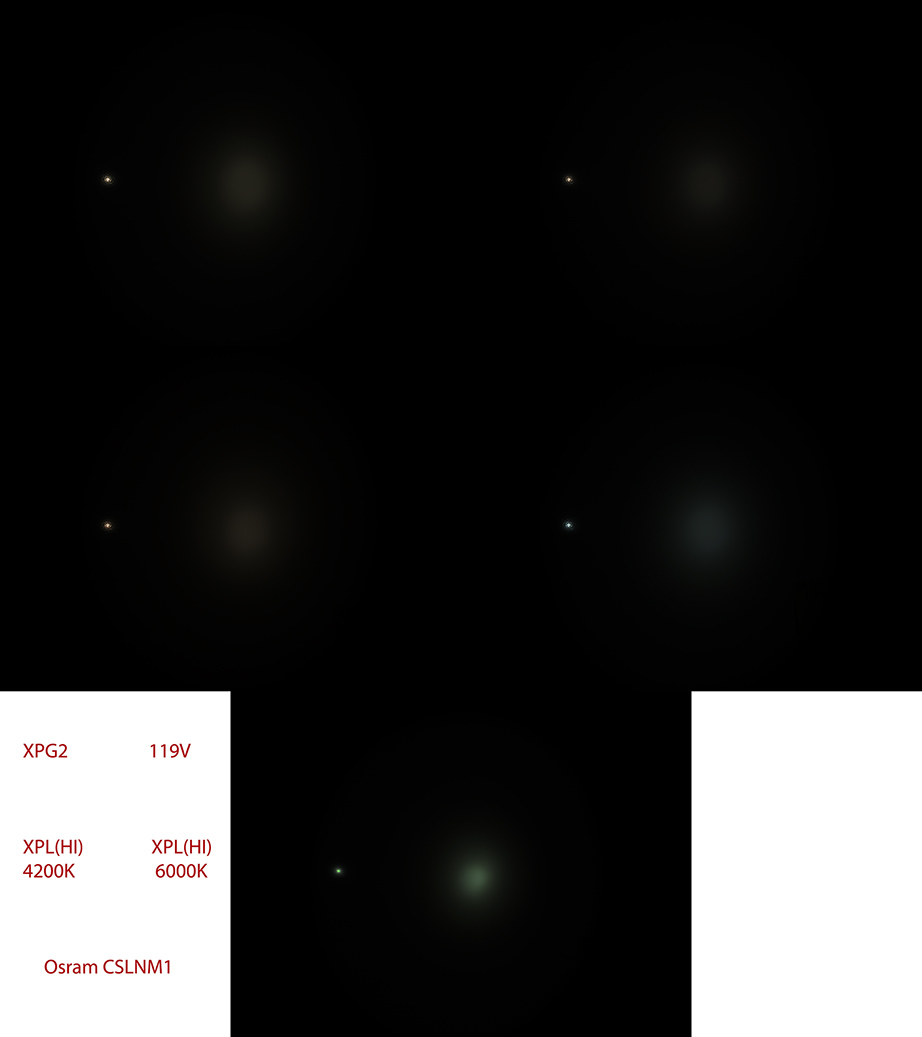Hi guys,
I haven't done any beam shots in a number of years and I do feel they can be as misleading as they are useful. But having messed with the Osram KW CSLNM1 LED I felt it necessary to try to provide some visual representation of what it is about. Similar to the Cree XPL(HI), the Osram has a flat silicone film over the LED die. This style lends itself better to use in a reflector as more off axis light is generated than a LED with a silicone dome. What is different about the Osram is the fact its die is much smaller than that of the Cree. Holding a caliper up to the LED's I guess the Cree die to be about 2.25 mm square where as the Osram is about 1.1 mm square. If we assume the Cree puts out 400 lumens at 1000mA then it has a surface intensity of roughly 70 lumens /sq mm. The Osram is rated from 250 - 400 lumens at 1000 mA. Using the figure of 300 lumens then it has a surface intensity of roughly 190 lumens /sq mm. The smaller die is also better collimated by a reflector so the spot is tighter and brighter by that virtue alone.
In order to try to capture the beam pattern as evenly as possible, I set up a Haiku reflector clamped at about 20 inches from the white face of a Tesla power wall (the location worked relative to my bench supply). I would hold the various LED's on MCPCB's up to the reflector and they were all driven at 60 mA. This close to the wall works against showing how the spot of the Osram holds together over distance but I would rather under play its difference than exaggerate it. I locked all five beam shots into the same image and then altered the group in Photoshot both increasing and decreasing the brightness to highlight the spill as well as dim the spot in attempt to illustrate the dynamic range and variation in the various LED's and their beam distributions.
First up is a reduced brightness that shows how the Osram holds up where the others have about disappeared:

Note as indicated, top row is XPG and then 119V, middle row is a pair of XPL(HI) differing in color temperature and then bottom is the Osram.
Next image give a better view of the spot beam:

And then a bit brighter exposure:

And then brightened up to show the relative spill portions:

A giff of the set:

I haven't done any beam shots in a number of years and I do feel they can be as misleading as they are useful. But having messed with the Osram KW CSLNM1 LED I felt it necessary to try to provide some visual representation of what it is about. Similar to the Cree XPL(HI), the Osram has a flat silicone film over the LED die. This style lends itself better to use in a reflector as more off axis light is generated than a LED with a silicone dome. What is different about the Osram is the fact its die is much smaller than that of the Cree. Holding a caliper up to the LED's I guess the Cree die to be about 2.25 mm square where as the Osram is about 1.1 mm square. If we assume the Cree puts out 400 lumens at 1000mA then it has a surface intensity of roughly 70 lumens /sq mm. The Osram is rated from 250 - 400 lumens at 1000 mA. Using the figure of 300 lumens then it has a surface intensity of roughly 190 lumens /sq mm. The smaller die is also better collimated by a reflector so the spot is tighter and brighter by that virtue alone.
In order to try to capture the beam pattern as evenly as possible, I set up a Haiku reflector clamped at about 20 inches from the white face of a Tesla power wall (the location worked relative to my bench supply). I would hold the various LED's on MCPCB's up to the reflector and they were all driven at 60 mA. This close to the wall works against showing how the spot of the Osram holds together over distance but I would rather under play its difference than exaggerate it. I locked all five beam shots into the same image and then altered the group in Photoshot both increasing and decreasing the brightness to highlight the spill as well as dim the spot in attempt to illustrate the dynamic range and variation in the various LED's and their beam distributions.
First up is a reduced brightness that shows how the Osram holds up where the others have about disappeared:

Note as indicated, top row is XPG and then 119V, middle row is a pair of XPL(HI) differing in color temperature and then bottom is the Osram.
Next image give a better view of the spot beam:

And then a bit brighter exposure:

And then brightened up to show the relative spill portions:

A giff of the set:



